Student house with a suffragette past
By: Jacqui Bealing
Last updated: Tuesday, 20 November 2018
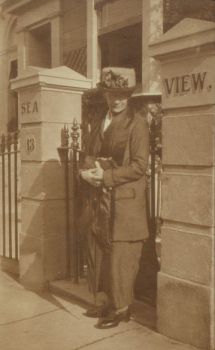
Minnie Turner outside Sea View.
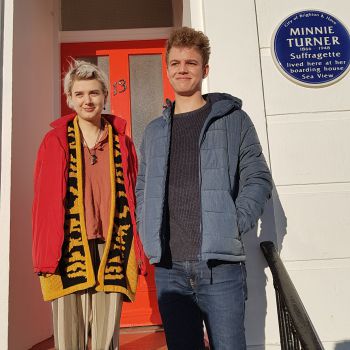
Students Sara Wilmot and Christian Wright, two of the current residents of what was once Minnie Turner's guest house.
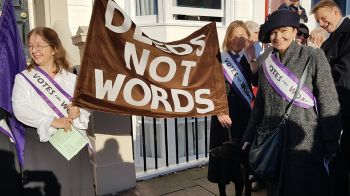
Deeds not words: Caroline Lucas MP gives her support in commemorating the life and work of Minnie Turner.
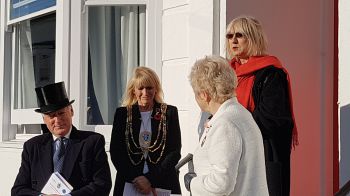
R-L: Professor Carol Dyhouse with Deputy Lieutenant of East Sussex Juliet Smith, Mayor of Brighton & Hove Cllr Dee Simson, and Roger Amerena, Chairman of Brighton and Hove Commemorative Plaque Panel.
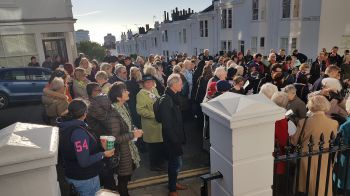
Shoulder to Shoulder: The crowd gathered for the unveiling of a plaque for Brighton suffragette Minnie Turner.
For the students who live there, it is just a delightful Victorian house in a salubrious part of Brighton with amazing sea views from the top windows.
But the four-storey property that’s been owned by the University of Sussex for more than 30 years is now also celebrated for the role it has played in women’s suffrage.
On 18 November historians, campaigners, politicians, residents and councillors gathered for the unveiling of a plaque on 13 Victoria Road to commemorate one of its former occupants, Minnie Turner.
Minnie, a suffragette whose name already adorns one of Brighton & Hove’s buses, ran a guest house and refuge for activists who, like her, fought for women to be given the vote.
And in honour of her on Sunday, the crowd, many of whom were dressed in the suffragette colours of green, lilac and white, joined in singing suffragette anthems, such as The Women’s Battle Song (to the tune of Onward Christian Soldiers), and Rise up Women! (to the tune of John Brown’s Body).
“You can feel the history in the house,” said Sara Wilmot, a History and English first-year who has been living at No. 13 since the start of term. “I feel so privileged. I’ll have to read up about Minnie.”
Her housemate, Christian Wright, an engineering student from Zimbabwe, was equally impressed. He said that the house was still a place for lively debate and discussion “…although mostly about who’s taken what from the kitchen,” he joked.
The plaque was unveiled by Deputy Lieutenant of East Sussex Juliet Smith. She paid tribute to Minnie, who lived in Victoria Road from 1910 until her death in 1948, by describing her as “both a radical and a pillar of the community”.
She reminded those gathered that not only was 2018 the centenary of women’s partial achievement of the vote, but that 18 November was also the date in 1910 when 300 women marched on Parliament. It became known as ‘Black Friday’ for the abuse and sexual assaults the marchers suffered.
Minnie had attended the protest with Emmeline Pankhurst’s sister Mary Clarke, who also lived at Minnie’s guest house, called Sea View. Mary was arrested and, after being force fed in prison, later died in Brighton of a brain haemorrhage; becoming the first casualty of the cause.
Minnie was also arrested three times. She was sent to Holloway Prison for three months in 1911 after breaking a window at the Home Office.
Sea View, whose guests included leading suffragettes such as Emmeline and Christabel Pankhurst, Annie Kenney, Flora Drummond, and Emily Wilding Davison (who died after being hit by the King’s horse at The Derby in 1913), became a place for suffragettes to recuperate after the horrors of imprisonment.
Addressing the crowd on Sunday, Carol Dyhouse, Emeritus Professor of History at Sussex, revealed that she has been “haunted by Minnie for several decades”, not least because she lived in the same road, and that many years ago, while her own home was being renovated, she found herself staying in what was once Minnie’s dining room.
Her curiosity about its former resident led to her tracking down one of Minnie’s nieces (Minnie herself didn’t have children). Carol said: “She knew someone would come after Minnie eventually. She showed me Minnie’s sash and her Holloway Prison brooch, which are now on display in Brighton Museum.”
Brighton Pavilion MP Caroline Lucas also paid tribute to Minnie and the women who fought for the right to vote. “We need to remember how brave and radical they were. They were beaten by police, imprisoned, and force fed. It’s no surprise that Mary Clarke died from that. I just want to remember the very high price that many women paid, and for the struggles that remain ahead.”
The plaque, the first for a suffragette in Brighton, was funded by Brighton & Hove City Council after first being proposed by Brighton & Hove Women’s History Group.
At a reception afterwards at the Brighton Centre, Jean Calder, secretary of the Women’s History Group, said: “This memorial for Minnie is long overdue. She was a formidable woman who made Sea View a hub for the suffrage movement in the South East of England.”
